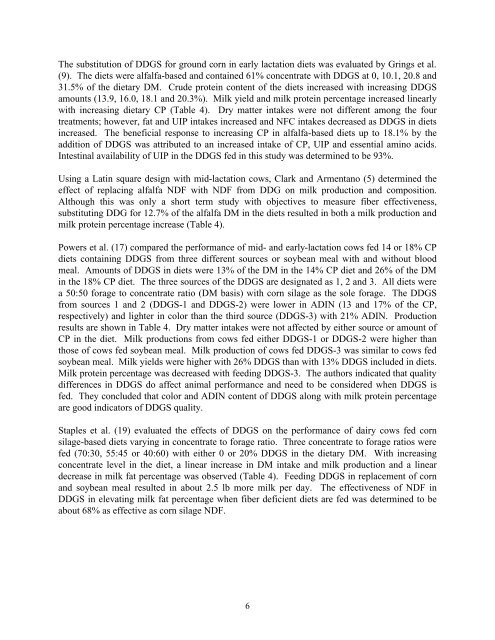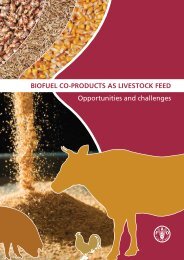Distillers Grains Feeding Recommendations. - Distillers Grains By ...
Distillers Grains Feeding Recommendations. - Distillers Grains By ...
Distillers Grains Feeding Recommendations. - Distillers Grains By ...
Create successful ePaper yourself
Turn your PDF publications into a flip-book with our unique Google optimized e-Paper software.
The substitution of DDGS for ground corn in early lactation diets was evaluated by Grings et al.(9). The diets were alfalfa-based and contained 61% concentrate with DDGS at 0, 10.1, 20.8 and31.5% of the dietary DM. Crude protein content of the diets increased with increasing DDGSamounts (13.9, 16.0, 18.1 and 20.3%). Milk yield and milk protein percentage increased linearlywith increasing dietary CP (Table 4). Dry matter intakes were not different among the fourtreatments; however, fat and UIP intakes increased and NFC intakes decreased as DDGS in dietsincreased. The beneficial response to increasing CP in alfalfa-based diets up to 18.1% by theaddition of DDGS was attributed to an increased intake of CP, UIP and essential amino acids.Intestinal availability of UIP in the DDGS fed in this study was determined to be 93%.Using a Latin square design with mid-lactation cows, Clark and Armentano (5) determined theeffect of replacing alfalfa NDF with NDF from DDG on milk production and composition.Although this was only a short term study with objectives to measure fiber effectiveness,substituting DDG for 12.7% of the alfalfa DM in the diets resulted in both a milk production andmilk protein percentage increase (Table 4).Powers et al. (17) compared the performance of mid- and early-lactation cows fed 14 or 18% CPdiets containing DDGS from three different sources or soybean meal with and without bloodmeal. Amounts of DDGS in diets were 13% of the DM in the 14% CP diet and 26% of the DMin the 18% CP diet. The three sources of the DDGS are designated as 1, 2 and 3. All diets werea 50:50 forage to concentrate ratio (DM basis) with corn silage as the sole forage. The DDGSfrom sources 1 and 2 (DDGS-1 and DDGS-2) were lower in ADIN (13 and 17% of the CP,respectively) and lighter in color than the third source (DDGS-3) with 21% ADIN. Productionresults are shown in Table 4. Dry matter intakes were not affected by either source or amount ofCP in the diet. Milk productions from cows fed either DDGS-1 or DDGS-2 were higher thanthose of cows fed soybean meal. Milk production of cows fed DDGS-3 was similar to cows fedsoybean meal. Milk yields were higher with 26% DDGS than with 13% DDGS included in diets.Milk protein percentage was decreased with feeding DDGS-3. The authors indicated that qualitydifferences in DDGS do affect animal performance and need to be considered when DDGS isfed. They concluded that color and ADIN content of DDGS along with milk protein percentageare good indicators of DDGS quality.Staples et al. (19) evaluated the effects of DDGS on the performance of dairy cows fed cornsilage-based diets varying in concentrate to forage ratio. Three concentrate to forage ratios werefed (70:30, 55:45 or 40:60) with either 0 or 20% DDGS in the dietary DM. With increasingconcentrate level in the diet, a linear increase in DM intake and milk production and a lineardecrease in milk fat percentage was observed (Table 4). <strong>Feeding</strong> DDGS in replacement of cornand soybean meal resulted in about 2.5 lb more milk per day. The effectiveness of NDF inDDGS in elevating milk fat percentage when fiber deficient diets are fed was determined to beabout 68% as effective as corn silage NDF.6
















